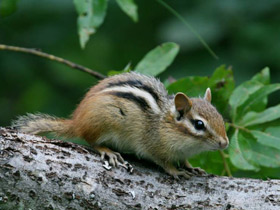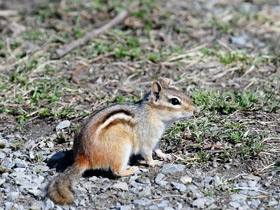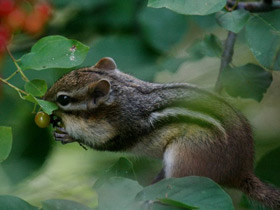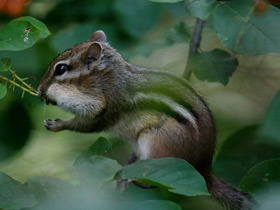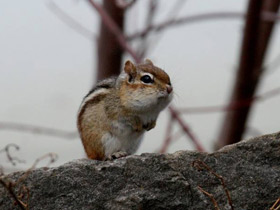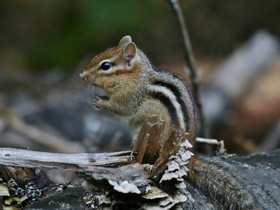The Siberian chipmunk (Eutamias sibiricus), common chipmunk
The Siberian chipmunk (Eutamias sibiricus), also called common chipmunk, is native to northern Asia from central Russia to China, Korea, and Hokkaidō in northern Japan. It was imported from South Korea and introduced in Europe as a pet in the 1960s.
Distinguishing features
This short furred, long-tailed animal, which looks like a small squirrel, is immediately recognisable by the dark and light longitudinal stripes on its back. There are quite a lot of such "striped squirrels" in the world - they live in the tropics of Asia and Africa, in North America. The chipmunk has a body length of 14-17 cm and a tail length of 10-13 cm. Although it is close to typical ground gophers and marmots in terms of kinship, the features of its body structure are quite "arboreal". Thus, Eutamias sibiricus has a big difference in length of hind and front legs, rather large ears, not so long claws. On the other hand, like gophers, it has cheek pouches for dragging small portions of food. The chipmunk's fur on the body is short, both in summer and in winter, while on the tail it is rather long and luxuriant, though without a squirrel's comb. The basic tone of the upper body is reddish grey; five narrow dark stripes alternate with whitish ones. The abdomen is white.
Habitat
The range of Eutamias sibiricus is extensive, covering the entire taiga zone of the Eurasian continent from the northern regions of Europe to the Pacific coast of Asia; however, it is not found on Kamchatka. Almost all of this range is in Russia, and only southern margins enter Mongolia, China and North Korea. In some places this rodent prefers to settle among larch forests, in others - in spruce-fir forests, in others it is most abundant in cedar forests and even in pine forests. In the south of its range, where taiga forests transition to deciduous forests, Eutamias sibiricus often inhabits birch forests with admixture of other species. Most often it can be found in cluttered native forests with a lot of dead wood, bushes and dense undergrowth, where it is easy for the animal to hide. However, Eutamias sibiricus lives not in the depths of the forest, but also in forest edges, river banks, on overgrown heaths and clearings, among stony screes overgrown with bushes, and along forested margins of agricultural fields.
Habitat, lifestyle and habits
The animal most often finds shelter in burrows, but rarely settles in hollow trees. Eutamias sibiricus do not dig burrows on scree slopes, but make nests in the hollows between stones. Their underground dwelling is of simple structure, with a single passage up to 3.5 metres in length, with a hatch opening usually under deadwood, tree roots or cobbles, depth depending on soil character is from 1 to 2.5 metres. The dwelling burrow has several snouts and chambers, one of which is a nesting chamber filled with dry grass and leaves, the others are used for winter food reserves. Eutamias sibiricus digs several other burrows on its territory for storing supplies. Like all squirrels, the chipmunk is active during the day. It climbs trees well, but spends most of its time on the ground. The animals give themselves away by constant whistling and sharp short trills - danger signals. They are especially noticeable in the second half of summer and autumn, when they scurry everywhere in search of food to be stored for the winter.
What Eutamias sibiricus feeds on
The main food of Eutamias sibiricus is seeds of various wild and cultivated plants. In the south of Siberia its favourite food is pine nuts, in the north - seeds of larch and spruce, in the subalpine and along the edges of kurums the animal collects berries of rose hips, lingonberries and blueberries. In deciduous forests it grazes on linden, maple, elm, honeysuckle and raspberry. In summer, Eutamias sibiricus together with other rodents raids agricultural fields and steals wheat and buckwheat grains. The animal rarely eats the food found on the spot, but quickly stuffs its cheek bags and hides in one of the temporary shelters, where it feasts in peace. By winter, the animal brings 2 to 6 kilogrammes of selected seeds into its burrow-hoard. These reserves are a tasty prey for many taiga inhabitants: other rodents, sable, wild boar, even bears.
Winter hibernation of Eutamias sibiricus
Eutamias sibiricus is characterised by a very long winter sleep: it begins in September-October and ends in March-April, in the north it lasts up to 7 months. During warming periods, the rodents awaken and visit stocks stored in the same or neighbouring burrows. Eutamias sibiricus usually does not eat everything during the winter, the leftovers are used in the hungry spring. However, if the larder of Eutamias sibiricus is ravaged by some four-legged robber, the hibernation for its owner does not always end favourably.
Reproduction
A few days after emergence from hibernation, Eutamias sibiricus begins the mating season and mating behaviour is observed. At this time, characteristic "gurgling" whistles are often heard, which females use to call males. Caretakers, losing all caution, gather to the calling cries: sometimes one can see several animals running 200-300 metres to the place where the coveted voice comes from, scurrying along branches one after another, huddling together in a fleeting fight.
Cubs appear in burrows in early June. A month later they start to make the first familiarisation excursions through the nearest thickets under the guidance of the female. And at the end of July the youngsters already pass to independent life, the main concern is to stock up for winter.
Invasion of Eutamias sibiricus
In the taiga zone, the industrious Eutamias sibiricus is considered to be one of the most harmful rodents. The animals not only destroy crops at the root, but also visit warehouses, and in poultry farms they manage to steal food directly from cages. In the south of Primorye, Eutamias sibiricus visit melons, literally "digging" into ripe pumpkins and watermelons to get to the seeds.
Invasiveness
In Europe, the Siberian chipmunk is included since 2016 in the list of Invasive Alien Species of Union concern (the Union list). This implies that this species cannot be imported, bred, transported, commercialized, or intentionally released into the environment in the whole of the European Union.
Ecology
Siberian chipmunks are essential food sources for other animals, such as diurnal raptors, weasels, and small cats. Other known predators include hawks, owls, and foxes. They evade being preyed upon by these animals by being alert, hiding in their burrows, and using their camouflaged fur to blend in with surroundings. They distribute seeds and fungal spores, and other animals feed off their stored food. They may help control forest tree pests. In Russia, they eat approximately 50 percent of the forest nuts. In Belgium, these chipmunks have been blamed for preying upon low-nesting birds.
If the species were introduced to Britain, it is possible that Siberian chipmunks may compete with other small animals, such as the red squirrel, wood mouse, and bank vole.
Subspecies
- Eutamias sibiricus sibiricus;
- Eutamias sibiricus asiaticus;
- Eutamias sibiricus lineatus;
- Eutamias sibiricus okadae;
- Eutamias sibiricus ordinalis;
- Eutamias sibiricus orientalis;
- Eutamias sibiricus pallasi;
- Eutamias sibiricus senescens;
- Eutamias sibiricus umbrosus.

















